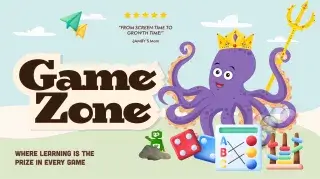

Written by: Kokotree
Last updated:

As parents, we’re always on the lookout for ways to keep our little ones entertained, engaged, and learning. Whether you’re dealing with energetic preschoolers or curious grade-schoolers, having a repertoire of engaging activities and questions can be a lifesaver. Not only do these activities provide entertainment, but they also contribute significantly to your child’s cognitive, social, and emotional development.
In this guide, we’ll explore a variety of engaging activities and questions that you can use with your kids. From trivia questions to riddles, from ‘would you rather’ scenarios to fun facts, we’ve got you covered. So, let’s dive in and discover how you can turn everyday moments into opportunities for fun, learning, and family bonding!
Trivia questions are a fantastic way to introduce new information to kids while having fun. They can cover a wide range of topics, from animals and nature to history and science.
For example, you might ask:
These questions not only test existing knowledge but also introduce new facts in an engaging way. For a treasure trove of age-appropriate trivia questions, check out our comprehensive list of trivia questions for kids.
For ages 2-6. They watch and play for 20 minutes. You get a break.
⭐ 5,000+ parents get daily breaks with Kokotree.
Try it Free →Works in 30 seconds • No credit card • Cancel anytime
True or False questions are excellent for developing critical thinking skills. They encourage kids to evaluate statements and decide whether they’re accurate or not. This process helps in building analytical skills and enhances their ability to discern fact from fiction.
You could try statements like:
For more examples and ideas, visit our collection of true or false questions for kids.
‘This or That’ questions present two options and ask the child to choose one. These questions can be about preferences, hypothetical scenarios, or even ethical dilemmas (for older kids). They’re great for developing decision-making skills and understanding personal preferences.
Some examples include:
Explore more options in our list of this or that questions for kids.
Similar to ‘This or That’, ‘Would You Rather’ questions often present more complex or imaginative scenarios. They’re excellent for sparking creativity and encouraging kids to think outside the box.
Try these:
Find more intriguing scenarios in our collection of would you rather questions for kids.
Conversation starters are open-ended questions that encourage kids to express their thoughts and feelings. They’re great for developing communication skills and building stronger family bonds.
Some examples:
Discover more conversation starters in our list of conversation starter questions for kids.
The classic ‘I Spy’ game is perfect for younger children, especially toddlers and preschoolers. It helps develop observation skills, expands vocabulary, and can be played anywhere.
How to play:
Learn more about how to play and variations of the game in our guide to I Spy for toddlers and preschoolers.
Riddles and brain teasers are excellent for developing problem-solving skills and lateral thinking. They challenge kids to look at problems from different angles and think creatively.
Here’s a simple example: Q: “What has keys but no locks, space but no room, and you can enter but not go in?” A: A keyboard!
For more brain-tickling riddles, check out our collection of riddles for kids.
Sharing fun facts is a great way to spark curiosity and encourage a love for learning. They can cover a wide range of topics and often lead to interesting discussions.
Did you know:
Discover more fascinating tidbits in our list of fun facts for kids.
Jokes are not only fun but also help in developing language skills and a sense of humor. They can also be a great way to lighten the mood and bond with your kids.
Here’s a classic: Q: Why don’t scientists trust atoms? A: Because they make up everything!
Find more giggles in our collection of jokes for kids.
These activities and questions offer numerous benefits for children:
Engaging activities and questions are powerful tools for parents. They transform ordinary moments into opportunities for learning, bonding, and fun. Whether you’re waiting at a restaurant, going on a long car ride, or just spending an evening at home, these activities can turn potentially dull moments into exciting adventures of the mind.
Remember, the goal isn’t just to keep kids busy, but to nurture their natural curiosity, encourage their love for learning, and strengthen your bond with them. As you explore these activities, you’ll likely learn and grow alongside your children.
So, why not start now? Pick an activity from this guide and try it out with your kids. You might be surprised at the conversations it sparks, the laughter it generates, and the memories it creates. Happy exploring, and here’s to many fun-filled, learning-packed adventures with your little ones!




